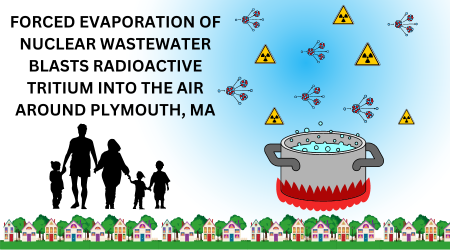Blog Post
There is no “away” with nuclear waste storage
- By C-10 Administrator
- •
- 11 May, 2017
Visitors from Texas, Michigan and Vermont call on us to work together for safer solutions

Rose Gardner watches the trucks filled with nuclear waste from around the country roll through her rural community on the Texas-New Mexico border. She’s worried about the plans to create a “high level” nuclear waste (HLNW) facility in her town — so-called interim storage — because there is no
permanent U.S. storage solution
for the most toxic stuff on earth. Besides that, the communities of Andrews County, Texas and Eunice, New Mexico are already impacted by an array of environmental contaminants.
Rose is a grandmother, owns a flower shop, and is an active member of the local
Sierra Club Chapter
. She became active in environmentalism when a company called Louisiana Energy Services applied for a license to enrich uranium with gas centrifuges for nuclear fuel rod production five miles from Eunice, raising concerns that the uranium waste could contaminate her water, air and land.
Waste Control Specialists already runs a hazardous waste dump, as well as a low level radioactive waste dump, also five miles from Eunice. The proximity of these and other nuclear-related industries, and their consequences for her town’s 2,800 residents, compelled Rose to raise awareness on the vulnerability of her small desert community; and to take her story on the road.
Last week, Rose traveled east to speak to people living near the nuclear power plants in Seabrook, N.H., Plymouth, Mass. and Brattleboro, VT. she joined experts from around the country on a speaking tour to raise awareness about the realities of what happens with “spent” nuclear fuel and nuclear reactors that have reached the end of their operating life — only to remain radioactive for many thousands of years.
Rose explained that she and her neighbors have no say in whether or not the waste comes to their town. No money, no protection for the watershed, and not much in the way of emergency response vehicles — other than some aging fire trucks made to fight prairie wildfires.
“Our lives matter just as much as yours,” Rose told the audience gathered in the basement of Central Congregational Church in Newburyport. “Our families deserve a safe place to live together and grow old. Let’s work together to find a solution,” Rose urged.
Deb Katz lives in rural Franklin County, Vermont, near the Yankee Rowe nuclear reactor being decommissioned by a company called North Star. Katz, who works with the group
Citizens Awareness Network
, explained how her host community and others like it around the country have suffered immeasurably, with the full health impacts yet unknown. Nuclear waste was once dumped
legally
into the Deerfield River, Katz told, noting the epidemic levels of birth defects, cancers and other diseases among her neighbors.
“This is the price for having a nuclear reactor in your backyard,” said Katz. “When we realized it was going to someone else’s town, we had to help,” Katz explained.
So they began organizing Caravans of Conscience, first visiting the South Carolina community where some of the waste from Yankee Rowe was going to be sent. “Reactor and waste communities have to work together,” said Katz. “We realized we couldn’t save ourselves by sacrificing someone else.”
“This is a moment of consciousness that people in the Northeast must take on,” said Katz, equating the issue of nuclear waste handling — which so often is pushed onto low income communities and areas with high minority populations — with the cause of the abolition of slavery. And there we were, sitting in a church next to the Inn named for William Lloyd Garrison, one of our state’s leading abolitionists.
“There is no good solution to the cleanup of nuclear waste,” said Katz. There are terrible ones, and then there are really bad ones. We’re trying to figure out what is the least harmful.”
Thirty states already ship their “less toxic” low-level nuclear waste to Andrews, Texas, and now Waste Control Specialists, despite being in financial disarray, is working on a plan to bring the high level waste there too.
Since plans to build a permanent storage site at
Yucca Mountain
, Nevada have stalled — despite decades of planning and millions invested — all high level nuclear waste now sits right on the grounds of nuclear power plants, and there are still
99 plants in operation in 30 states
. Some estimates are that there are over 600 metric tons of the stuff at our own Seabrook Station, which has been generating power since 1991.

Kevin Kamps of the group
Beyond Nuclear
traveled from his home in Michigan to speak about federal policy underlying the vulnerabilities of on-site storage of HLNW. Kamps has served as a radioactive waste watchdog for 25 years. He has helped lead national environmental justice campaigns, opposing the Yucca Mountain, permanent burial dump sited on Western Shoshone sacred treaty land; and the development of “centralized interim storage facilities” for high level nuclear waste near Native American and other minority communities.
Kevin explained what would happen if nuclear plants are permitted to start moving their waste to a place like Andrews in what have been dubbed “Mobile Chernobyls.” These would be targets for terrorists and criminals, subject to accidents and extreme weather. Not good at all.
The idea of the most radioactive stuff on earth — some of which could remain harmful to humans for hundreds of thousands of years, crisscrossing the nation by truck, train and even barge — is chilling to say the least. Remember that human civilization as we know it dates back only about 12,000 years.
There is consensus building around the country that high-level nuclear waste — the worst of the bad stuff — should stay in the state where it was generated. And that a permanent solution, probably deep geological storage that is scientifically proven and involves the consent and compensation of host communities, is the only way.
“We who live in the communities where corporations generate the most deadly toxins on earth, must help prevent the migration of these toxins into other communities,” said Chris Nord, a C-10 board member who helped arrange the event.
“Those responsible for their creation should not be allowed to dodge accountability for isolating these wastes by targeting distant communities for their disposal. The transportation and storage of high level nuclear waste must not proceed without the express informed consent of the affected transport corridor communities, and those targeted for so-called ‘interim’ dump sites,” said Nord.
Katz said that it’s at decommissioning that the true foley of nuclear power becomes clear. That it is not a clean energy source; far from it.
Residents living near Seabrook
—
like those in other towns that are home to a nuclear power plant
—
bear greater risks to their health and safety every day. While the risks aren’t entirely clear, what we do know is that there is no “away” with nuclear waste. This stuff will be with us far longer than the seventh generation of Native American teachings. How we will work together to minimize the impacts on humans and the environment is one of our greatest challenges.
Local Sponsors of the May 4, 2017 talk on High Level Nuclear Waste:
C-10 Research and Education Foundation
,
Merrimack Valley People for Peace
,
No More Fukushimas,
RISE Newburyport
,
Society of Friends, Amesbury
and
Seacoast Anti-Pollution League
.
Tour Organizers:
Citizens Awareness Network
, the
Safe and Green Campaign
, the Vermont Yankee Decommissioning Alliance.
C-10 Research & Education Foundation, Inc.
11 Chestnut Street
Amesbury, MA 01913
Phone: (978) 465-6646
Email: info@c-10.org



